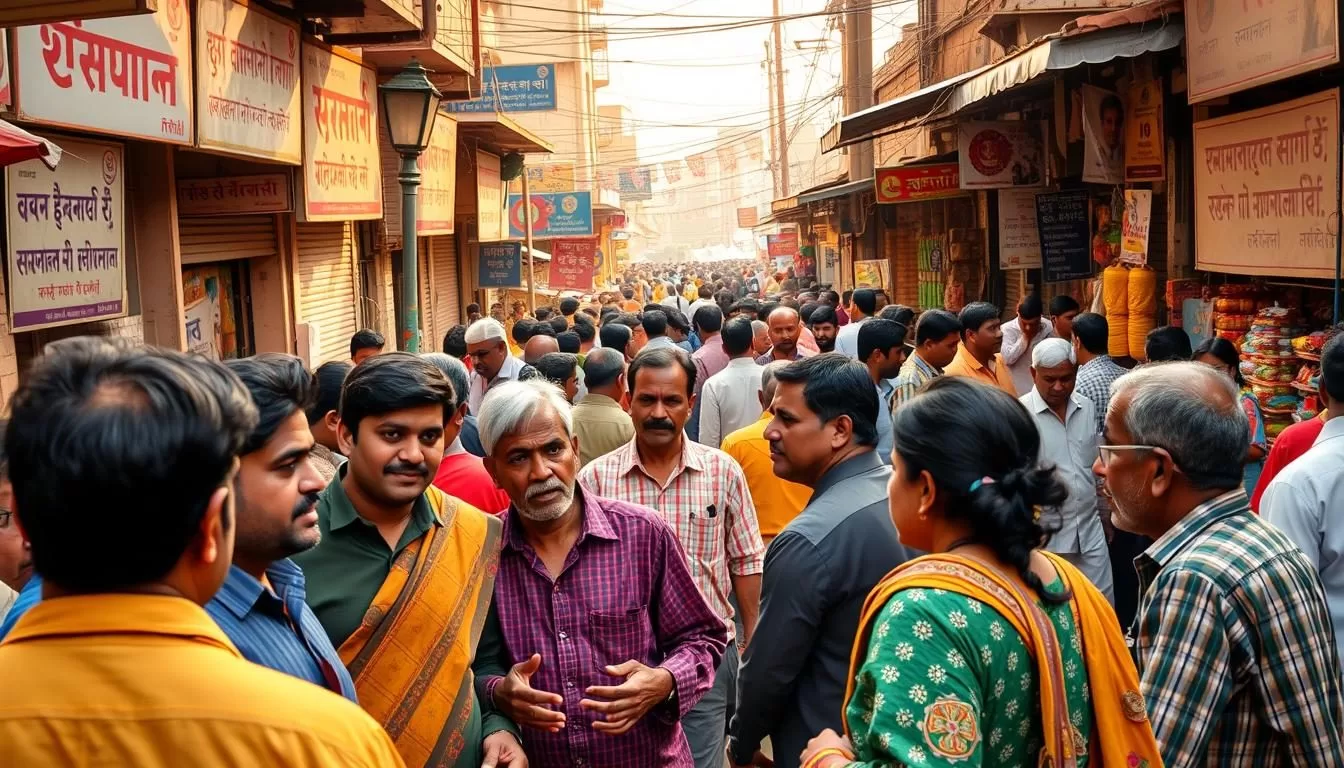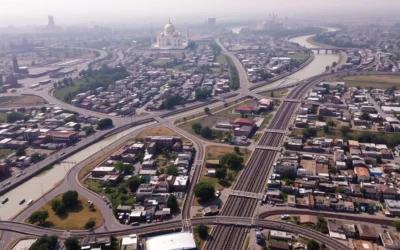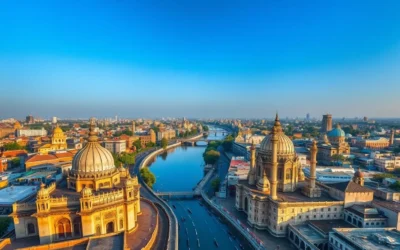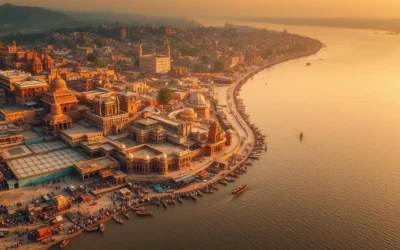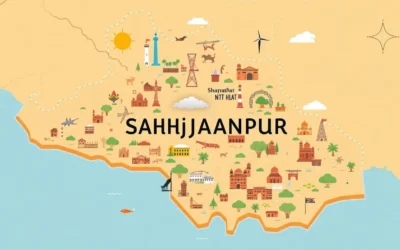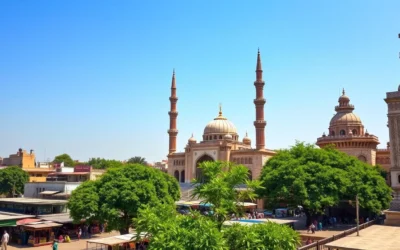✓ Accommodations✓ Flights✓ Rental Cars✓ Tours & Activities
You’ll explore the rich linguistic tapestry of Uttar Pradesh, a state in northern India with a population exceeding 241 million people.
This multilingual state is home to three predominant languages and 26 other languages, belonging to the Central and East zones of the Indo-Aryan languages.
As you delve into the language landscape, you’ll find that Hindi is the official language, accompanied by Urdu as co-official, while Bhojpuri stands as the second most spoken language with over 25.5 million speakers.
The linguistic composition of Uttar Pradesh is a reflection of its cultural heritage and regional identity.
Linguistic Landscape of Uttar Pradesh
Uttar Pradesh’s geographic expanse and demographic complexity have given rise to a rich tapestry of languages and dialects. The state’s vast area of 243,286 square kilometers and its borders with multiple states and Nepal have significantly influenced its language development.
Geographic and Demographic Overview
Uttar Pradesh is characterized by its diverse geography and demographics. With 75 districts across 18 divisions, the state’s population distribution plays a crucial role in shaping its linguistic landscape. The capital, Lucknow, and other major cities like Varanasi and Kanpur, are melting pots of various linguistic traditions due to historical and contemporary migration patterns.
The Ganges plain, a significant geographic feature, has also contributed to the creation of distinct linguistic zones within the state. Different language families predominate in different areas, adding to the linguistic diversity.
| Region | Major Languages/Dialects | Significant Features |
|---|---|---|
| Eastern Uttar Pradesh | Bhojpuri | Closely related to the cultural practices of the region |
| Central Uttar Pradesh | Awadhi | Historically significant, with influences from ancient languages |
| Western Uttar Pradesh | Braj Bhasha | Rich literary tradition, associated with the Krishna cult |
Historical Development of Languages in the Region
The historical evolution of languages in Uttar Pradesh has been influenced by various factors, including ancient Sanskrit, medieval Persian, and Arabic. These historical layers have created the current linguistic mosaic. The region’s position as a cultural and political center throughout Indian history has made it a melting pot for various linguistic traditions.
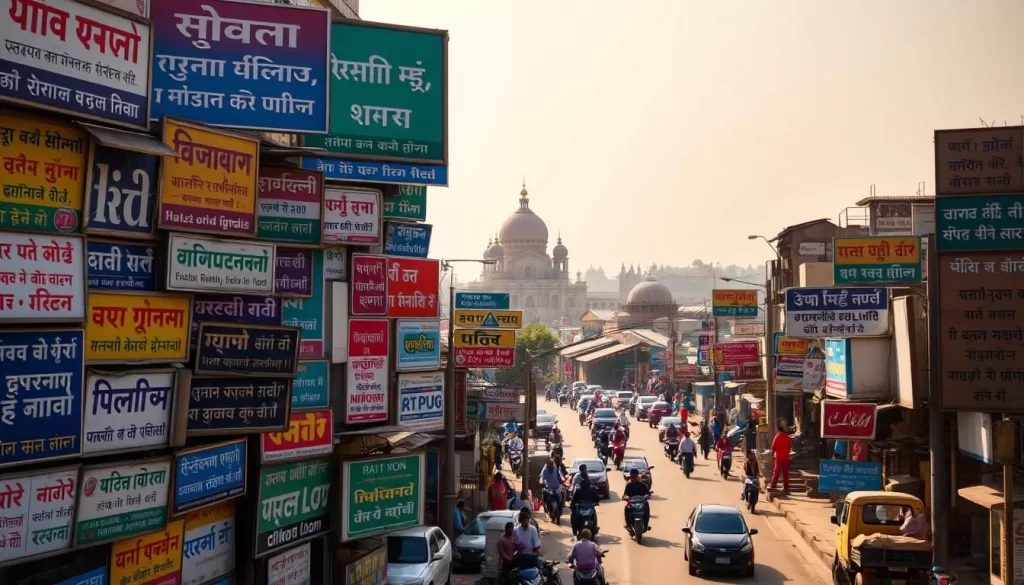
The distinction between “languages” and “dialects” as classified in the Indian census also plays a crucial role in understanding the linguistic landscape. Mother tongues are grouped within larger language categories in official records, which sometimes leads to the classification of a ‘mother tongue’ as a dialect rather than a language by linguistic standards.
Official Languages of Uttar Pradesh, India
As the most populous state in India, Uttar Pradesh has adopted a bilingual approach to its official language policy. This approach recognizes the cultural and linguistic diversity of its population.
Hindi: Primary Official Language
Hindi is the primary official language of Uttar Pradesh, established by the Uttar Pradesh Official Language Act of 1951. It is written in the Devanagari script and serves as the language of government, education, and formal communication across the state. As the most widely spoken language, Standard Hindi acts as a lingua franca, facilitating communication among people from different regions.
According to census data, Hindi is spoken by approximately 80.16% of the population, making it the dominant language in the state. The use of Standard Hindi helps in maintaining administrative coherence and facilitates the functioning of government offices, courts, and educational institutions.
| Language | Percentage of Speakers |
|---|---|
| Hindi | 80.16% |
| Bhojpuri | 10.93% |
| Urdu | 5.42% |
| Awadhi | 1.9% |
| Others | 1.59% |
Urdu: Second Official Language
Urdu became the second official language of Uttar Pradesh through an amendment to the Official Language Act in 1989. This recognition reflects the state’s multicultural heritage and the significant presence of Urdu-speaking populations, particularly in cities like Lucknow, which has a rich history of Urdu literature and poetry.
The official status of Urdu has implications for education, governance, and cultural expression. It ensures that Urdu-speaking communities have access to government services and educational opportunities in their mother tongue, promoting inclusivity and cultural preservation.
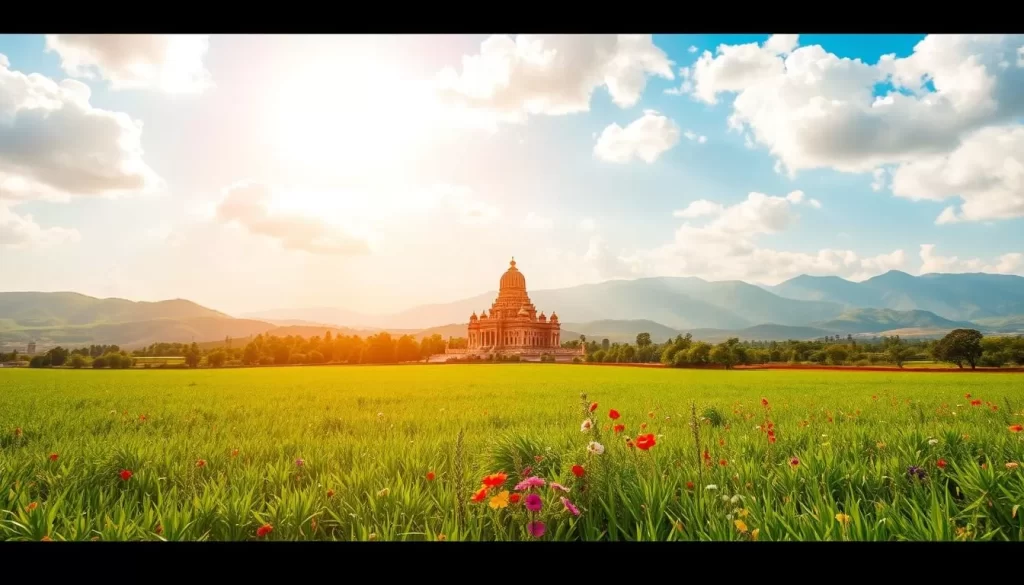
Major Regional Languages Across Uttar Pradesh
As you explore the linguistic diversity of Uttar Pradesh, you’ll discover several regional languages that play a crucial role in shaping the state’s identity. These languages are not only significant in terms of the number of speakers but also contribute to the rich cultural heritage of the region.
Bhojpuri in Eastern Uttar Pradesh
Bhojpuri is an Indo-Aryan language predominantly spoken in the eastern parts of Uttar Pradesh, particularly in the Bhojpur-Purvanchal region. It is widely spoken in districts such as Varanasi, Gorakhpur, Ballia, and Azamgarh. With over 25.5 million speakers, Bhojpuri is the second most widely spoken language in Uttar Pradesh, accounting for around 11% of the population. The language has a vibrant cultural scene, including a thriving film industry and traditional folk music like Birha and Kajri. Structurally, Bhojpuri differs from Standard Hindi, with its own distinct grammatical features and vocabulary.
Awadhi in Central Uttar Pradesh
Awadhi is another major language spoken in the central regions of Uttar Pradesh. Districts such as Lucknow, Ayodhya, and Sultanpur are among the areas where Awadhi is commonly spoken. The language is renowned for its literary heritage, most notably the epic Ramcharitmanas by Tulsidas, which is considered a masterpiece of Awadhi literature. Awadhi has its own unique flavor and is an integral part of the cultural identity of central Uttar Pradesh.
Braj Bhasha in Western Uttar Pradesh
Braj Bhasha, or simply Braj, is primarily spoken in the western parts of Uttar Pradesh, particularly in areas associated with Lord Krishna, such as Mathura and Agra. The language has a deep connection to Krishna devotional literature and classical music, making it an essential part of the region’s cultural fabric. Braj Bhasha is spoken in districts like Mathura, Agra, Hathras, and Aligarh, and is known for its distinctive features that set it apart from other regional languages.
Bundeli in Southern Uttar Pradesh
Bundeli is the primary language of the Bundelkhand region in southern Uttar Pradesh. It is spoken in districts such as Jhansi, Banda, Chitrakoot, and Lalitpur. Bundeli has its own unique vocabulary and grammatical structures, distinguishing it from other languages in the state. The language is an important marker of cultural identity in the region and is used in various folk traditions and everyday communication.
These regional languages, while distinct, are closely related to Standard Hindi, sharing many similarities yet maintaining their unique identities. They serve as markers of cultural identity and regional pride, often being the preferred languages for folk traditions, festivals, and everyday communication.
| Language | Region | Districts | Notable Features |
|---|---|---|---|
| Bhojpuri | Eastern Uttar Pradesh | Varanasi, Gorakhpur, Ballia, Azamgarh | Vibrant film industry, folk music like Birha and Kajri |
| Awadhi | Central Uttar Pradesh | Lucknow, Ayodhya, Sultanpur | Literary heritage, epic Ramcharitmanas |
| Braj Bhasha | Western Uttar Pradesh | Mathura, Agra, Hathras, Aligarh | Connection to Krishna devotional literature and classical music |
| Bundeli | Southern Uttar Pradesh (Bundelkhand) | Jhansi, Banda, Chitrakoot, Lalitpur | Unique vocabulary and grammatical structures |
Lesser-Known Languages and Dialects
As you explore the linguistic diversity of Uttar Pradesh, you’ll discover several lesser-known languages and dialects that are integral to the region’s cultural identity. These languages, though not as widely recognized as the official languages, play a vital role in the daily lives and cultural practices of the people in different regions of Uttar Pradesh.
Kannauji Language and Its Distribution
The Kannauji language is spoken by approximately 7 million people across various districts in Uttar Pradesh, including Kanpur, Farrukhabad, and Etawah. It has three sub-variants: Kannauji Proper, Tirhari, and Transitional Kannauji. Most Kannauji speakers identify their language as “Dehati” or village variety. Despite its widespread use, there’s an ongoing shift toward Standard Hindi, especially among younger and educated speakers.

Bagheli and Its Speakers
Bagheli is another significant language spoken in the southeastern corner of Uttar Pradesh, encompassing districts like Banda, Chitrakoot, and parts of Prayagraj. It is related to other Central Zone Indo-Aryan languages. Bagheli speakers maintain their linguistic identity, although the language is facing challenges due to the increasing influence of Standard Hindi in formal situations.
Khari Boli and Other Dialects
Khari Boli, a dialect of Hindi, is widely spoken in the western regions of Uttar Pradesh, including districts like Meerut, Saharanpur, and Muzaffarnagar. It forms the basis of Standard Hindi but retains distinctive features as a regional dialect. The sociolinguistic dynamics affecting these lesser-known languages include attitudes toward them in formal situations and their perceived status compared to Standard Hindi.
Some key aspects of these lesser-known languages include:
- Unique phonological and grammatical features, such as Kannauji’s processes of fortition, nasalization, and vowel insertion.
- The influence of education, urbanization, and media on the vitality of these languages, with some facing endangerment as younger generations prefer Standard Hindi.
- The role of these languages in maintaining cultural identity and regional distinctiveness.
Understanding these lesser-known languages and dialects provides insight into the rich linguistic diversity of Uttar Pradesh and highlights the importance of preserving cultural heritage in the face of changing linguistic landscapes.
Linguistic Features and Cultural Significance
As you explore Uttar Pradesh, you’ll discover a fascinating array of languages that not only reflect the state’s cultural heritage but also its linguistic diversity. The region’s linguistic landscape is characterized by a rich tapestry of languages, each with its unique features and significance.
Writing Systems and Scripts
The writing systems across Uttar Pradesh vary, with the Devanagari script being predominant for Hindi and most regional languages. In contrast, Urdu is written in the Nastaliq style of the Perso-Arabic script. Historically, the Kaithi script was widely used, but its usage declined with the promotion of Devanagari by the Nagari Pracharini Sabha, formed in 1893.
Phonological and Grammatical Distinctions
Languages in Uttar Pradesh, such as Kannauji, exhibit distinct phonological features that differentiate them from Standard Hindi. For instance, Kannauji has unique processes like fortition, nasalization, and vowel insertion. Grammatical variations are also evident in verb conjugation, noun declension, and sentence structure, reflecting the independent linguistic development of these languages.
Role of Languages in Cultural Identity
Languages in Uttar Pradesh serve as repositories of cultural knowledge, preserving traditions through oral literature, folk songs, proverbs, and idioms. They express the unique worldview of different communities and play a crucial role in cultural identity. The use of these languages in various life domains reflects both cultural continuity and linguistic change in contemporary Uttar Pradesh.
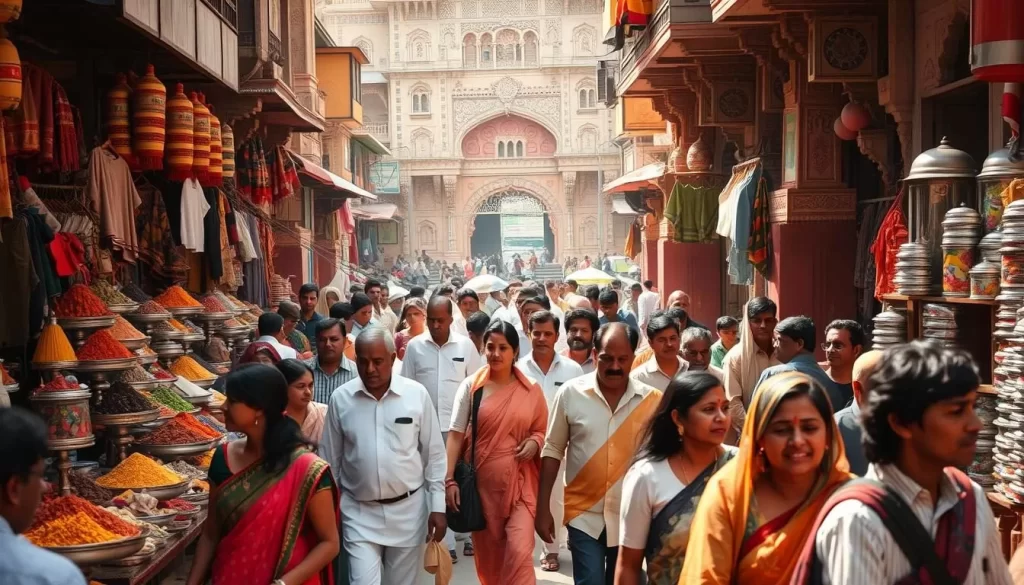
Conclusion: The Future of Linguistic Diversity in Uttar Pradesh
As we reflect on the linguistic landscape of Uttar Pradesh, we are faced with the reality that the status of regional languages is at a crossroads. The growing dominance of Standard Hindi in education, media, and public life is a trend that affects the vitality of regional languages.
You have seen how diglossia characterizes the relationship between Standard Hindi and regional languages, with the former being used in formal contexts and the latter in personal and community settings. Efforts to revitalize regional languages include educational initiatives and cultural programs.
The use of digital technology and social media is creating new opportunities for language preservation. Despite the socioeconomic factors influencing language choices, there’s a growing interest in maintaining linguistic diversity. As you consider the future of Uttar Pradesh’s languages, it’s clear that balancing standardization with the preservation of regional languages is key.
Uttar Pradesh’s experience offers valuable insights into broader questions about language policy and cultural identity in multilingual societies.
The above is subject to change.
Check back often to TRAVEL.COM for the latest travel tips and deals.
